
Widely popular throughout Japan, tamago, or egg, sushi, is a nigiri sushi that’s as beautiful as it is delicious. Seasoned eggs cooked into a layered omelette is the primary ingredient in this Japanese treat. As it contains no raw fish, it’s a great option for those new to sushi or hesitant to try anything raw.
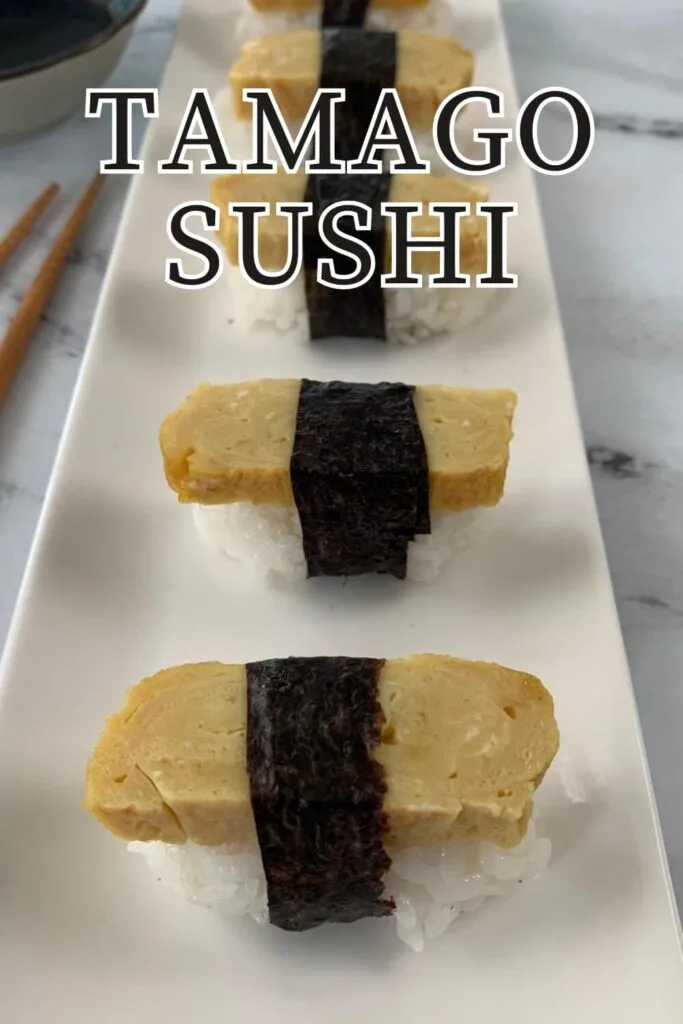
Table of Contents
What is Tamago Sushi
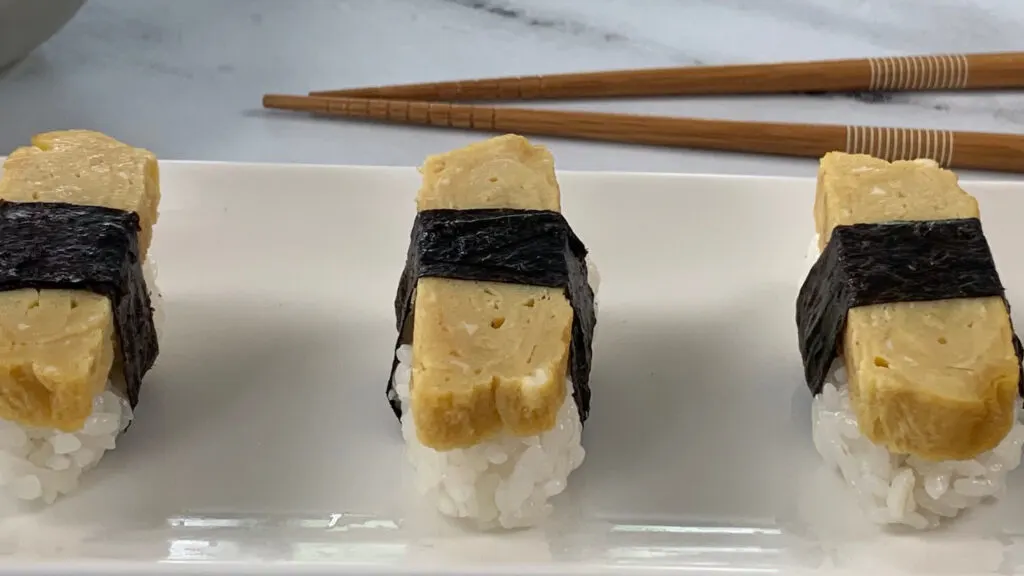
Tamago sushi translates to “egg sushi” and consists of a slice of tamagoyaki (Japanese omelette) draped over a ball of rice and held in place by a strip of nori (seaweed wrapper). The rich flavors of the egg and seasonings go well with the vinegar of the sushi rice.
The flavors and appearance of tamagoyaki can vary depending on the region where it’s cooked or the occasion for which it’s cooked. For example, in Tokyo tamagoyaki tends to have a darker color and be sweeter as it uses more sugar, a regular soy sauce, and less dashi. In Kyoto tamagoyaki uses more dashi, a lighter soy sauce and no sugar, giving it a more salty flavor and lighter color (this style is often called dashimaki tamago).
Personally, I enjoy more bold flavors in my tamagoyaki. As such, I prefer to use dashi powder as opposed to regular dashi as the powder packs more of a concentration of flavor. If you prefer a more subtle flavor, you can use a couple tablespoons of dashi instead.
How to Make Tamago Sushi
While this sushi contains only a few components, the tamagoyaki may seem a little intimidating for those new to it. However, it’s easier than it looks once you understand the process. I encourage you to watch the video to give you a visual reference on how to layer the tamagoyaki.
Cook Sushi Rice
1. Rinse 2/3 cup of sushi rice by placing it in a colander and running water through it until the water is clear.
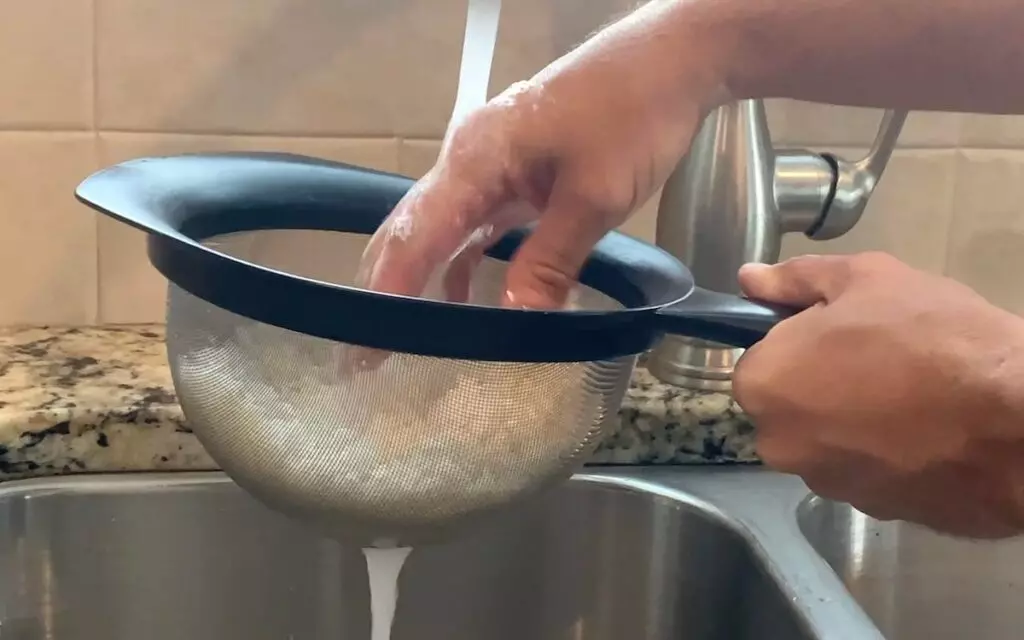
2. After the rice is rinsed, add it to a sauce pan with 1 cup of water (I would check the instructions on the sushi rice package to see exactly how much water to add as it can vary depending on the brand).

3. Bring the water to a boil and then reduce the heat to low. Cover and let the rice simmer for 20 to 30 minutes, or until the water is absorbed and the rice is soft.
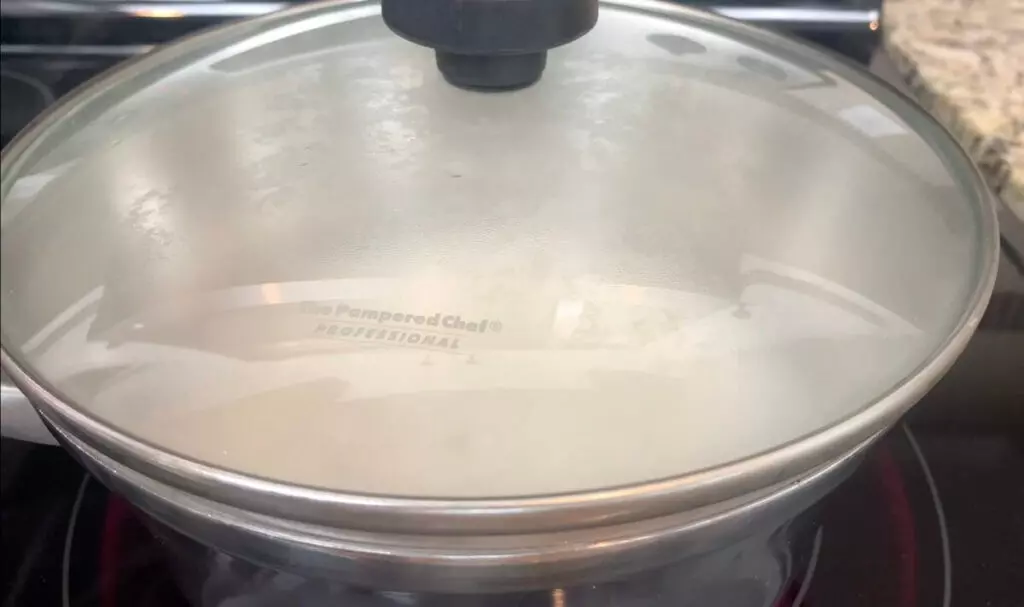
4. Remove the rice and place into a bowl or dish and let cool. I would line the dish with parchment paper prior to adding the rice to avoid sticking.
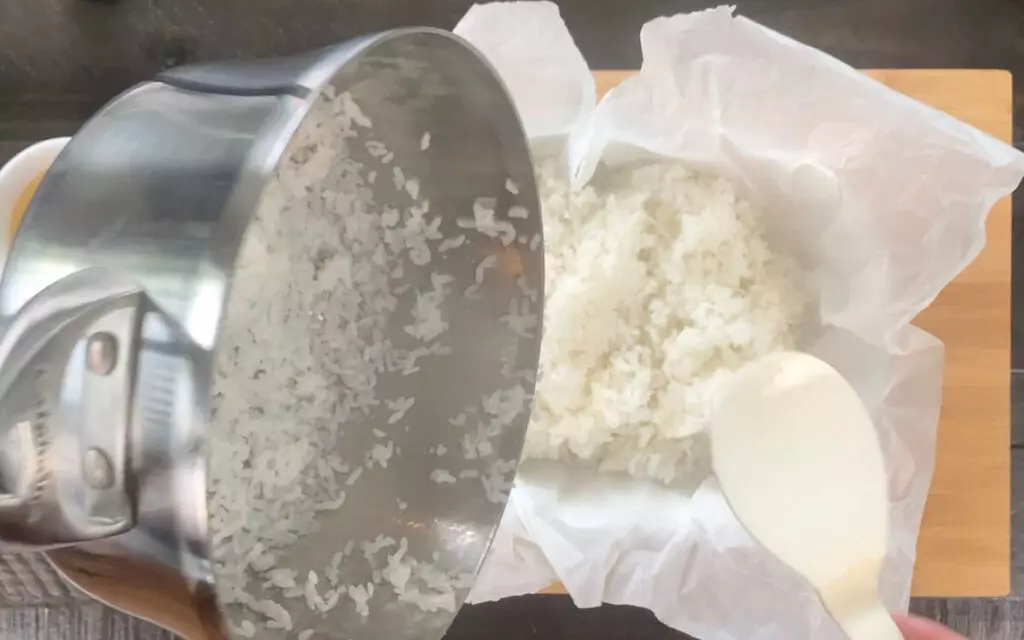
5. Mix two tablespoons of sushi vinegar into your rice. Stir until it has absorbed into the rice. Once cooled and fully absorbed, your rice is ready to roll!

Prepare the Tamagoyaki
1. Add the eggs, mirin, soy sauce, sugar, and dashi powder to a mixing bowl and whisk until everything is thoroughly mixed. I like using dashi powder in this mixture because it provides a strong concentration of dashi flavor to the omelette. However, you can substitute with two tablespoons of dashi if you would like a more subtle flavor in your tamagoyaki.

2. Heat a tamagoyaki pan or skillet on medium heat until hot.
3. Spread a thicker layer of oil on the bottom of the pan. I soak a folded paper towel in canola oil and use that to spread oil across the bottom and sides of the pan with tongs or chopsticks.
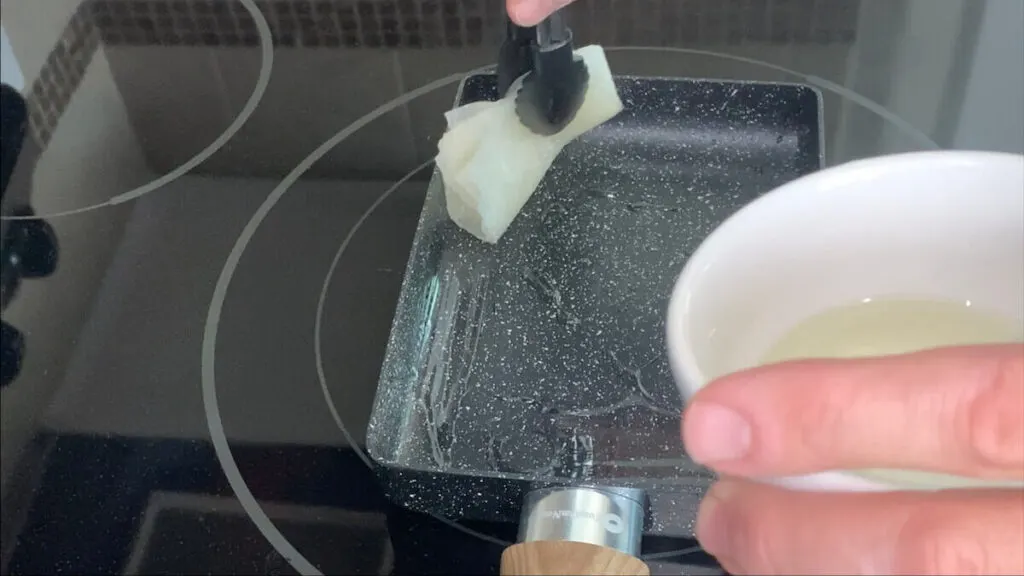
4. Pour approximately 1/4 of the egg mixture into the bottom of the pan. Tilt the pan to make sure it’s evenly spread across the bottom of the pan.
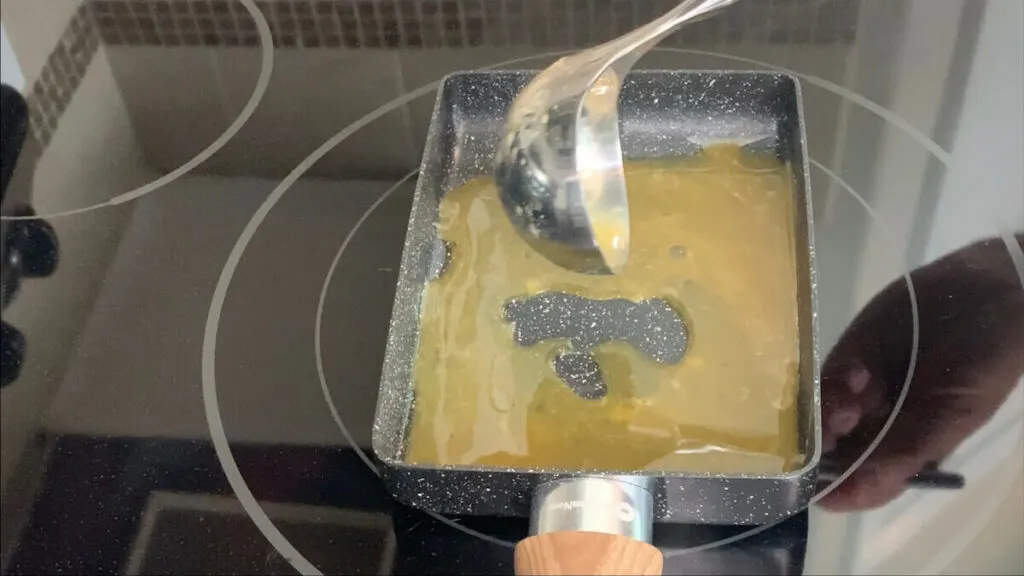
5. Once the egg starts cooking (around 30 seconds depending on how hot the pan is), use a spatula or chopsticks to fold the egg mixture on top of itself towards one side of the pan. At this stage, the omelette doesn’t need to look perfect. It will look better with each layer. Tip: Check out the video for this recipe to see a demonstration of this process.
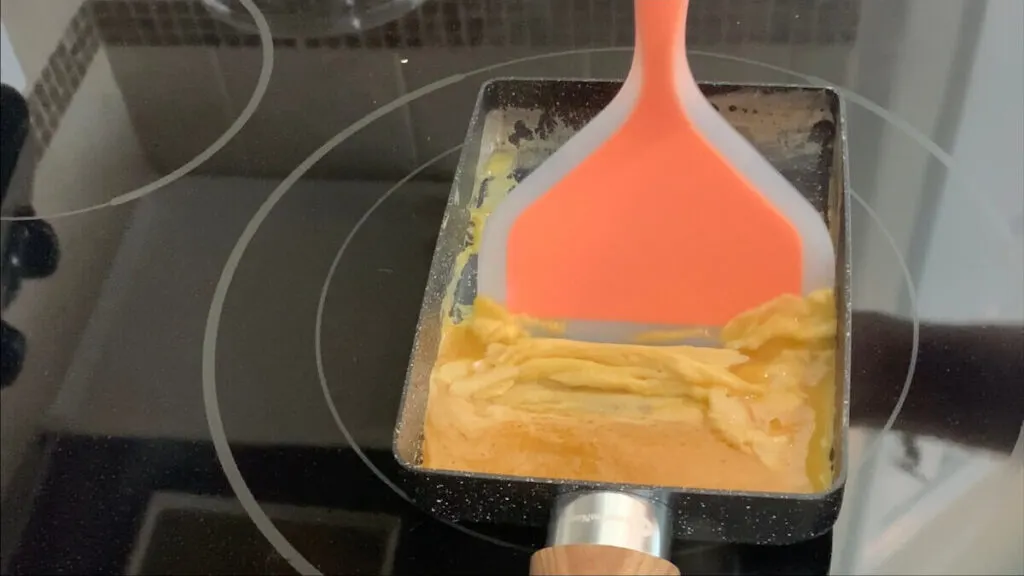
6. Add another 1/4 of the mixture to the bottom of the pan. Gently lift the mixture that has already been folded and tilt the pan assuring the mixture is spread evenly across the bottom of the pan (including under the mixture that has already been folded).
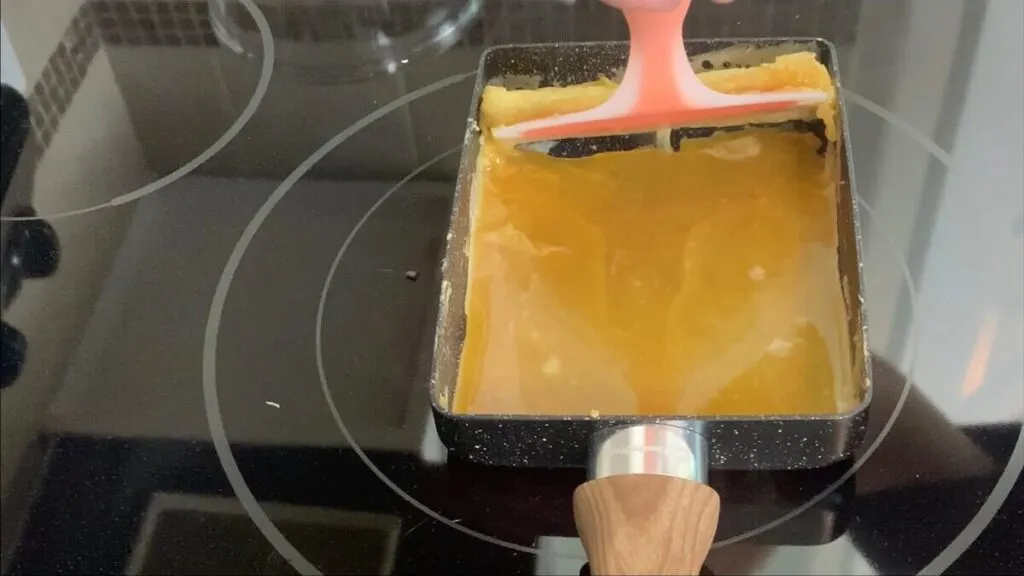
7. Once the second layer of egg starts cooking, use a spatula or chopsticks to fold the egg mixture on top of itself and the already cooked layer of folded egg. I like to use a spatula to form the egg into a rectangle shape as you fold each layer.
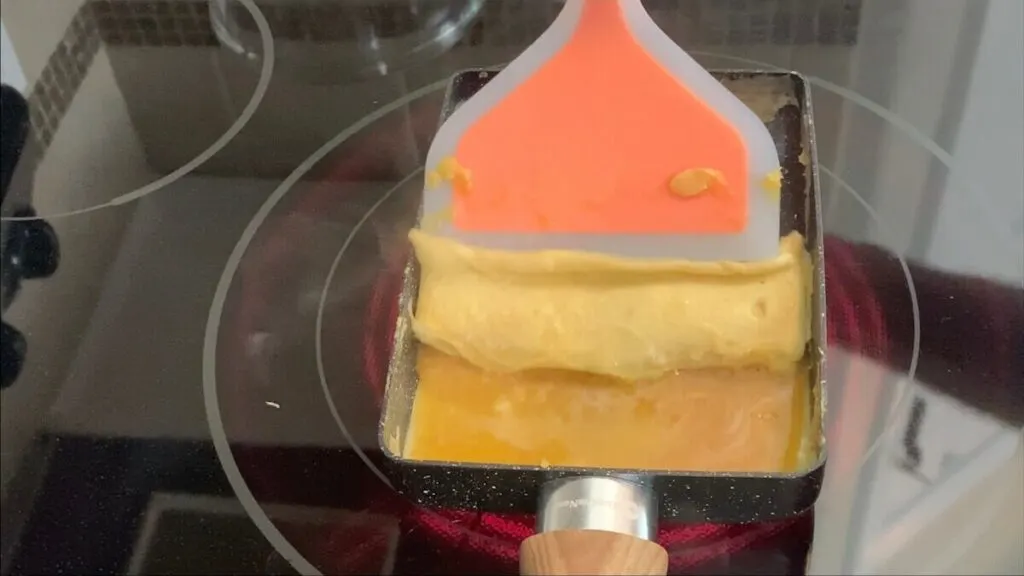
8. Repeat the process two more times until all the egg mixture has been used. You may need to add more oil to the pan between layers if you find that your eggs are sticking.
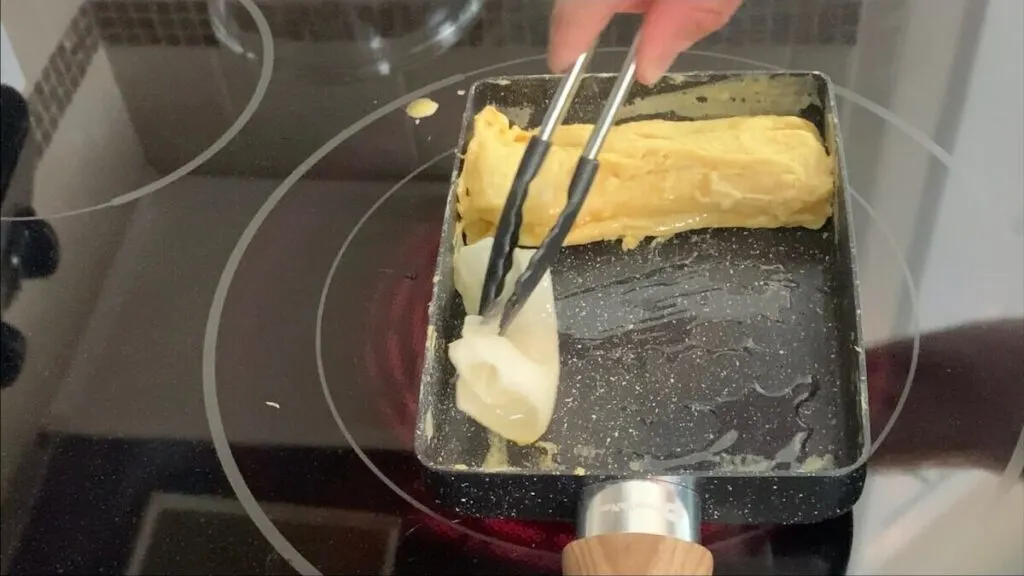
9. After the final layer, use a spatula to shape the tamagoyaki into a rectangle shape.
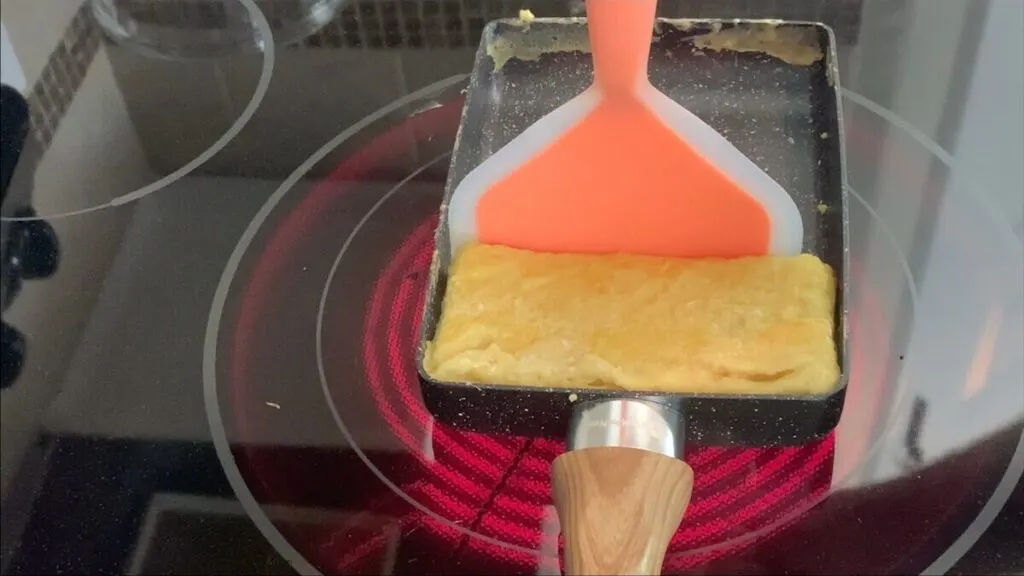
10. Once cooked, slice into 12 evenly sized slices.
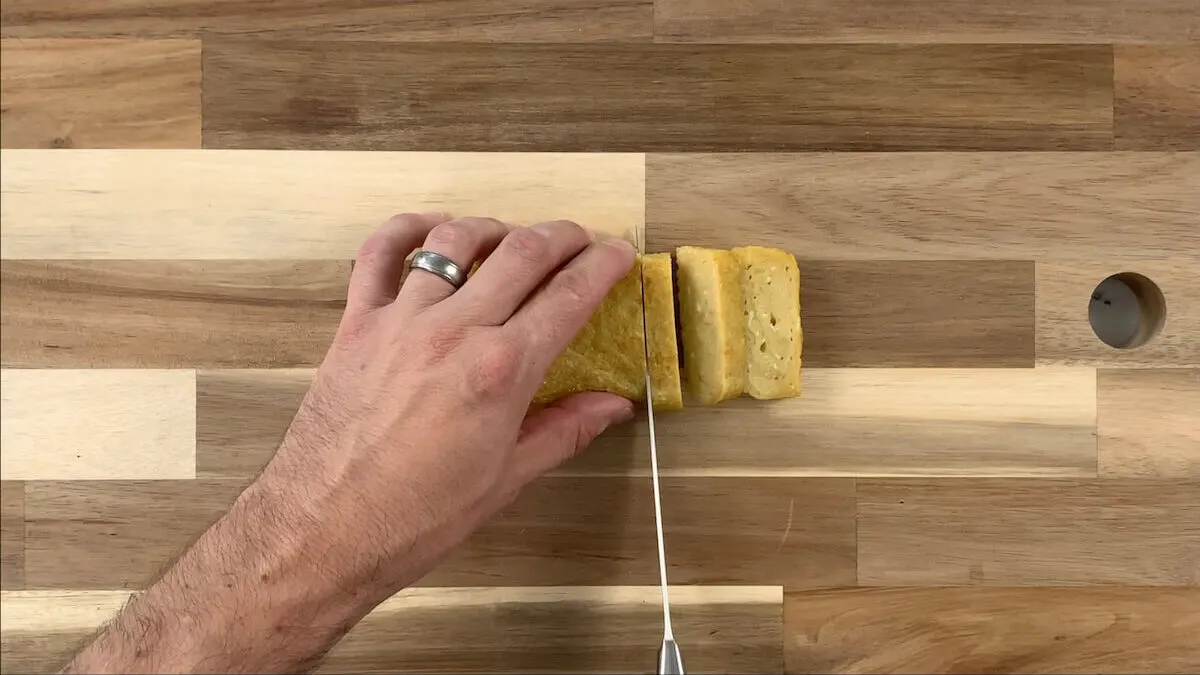
Assemble the Tamago Sushi
1. Cut the nori sheets into strips about one half an inch wide.
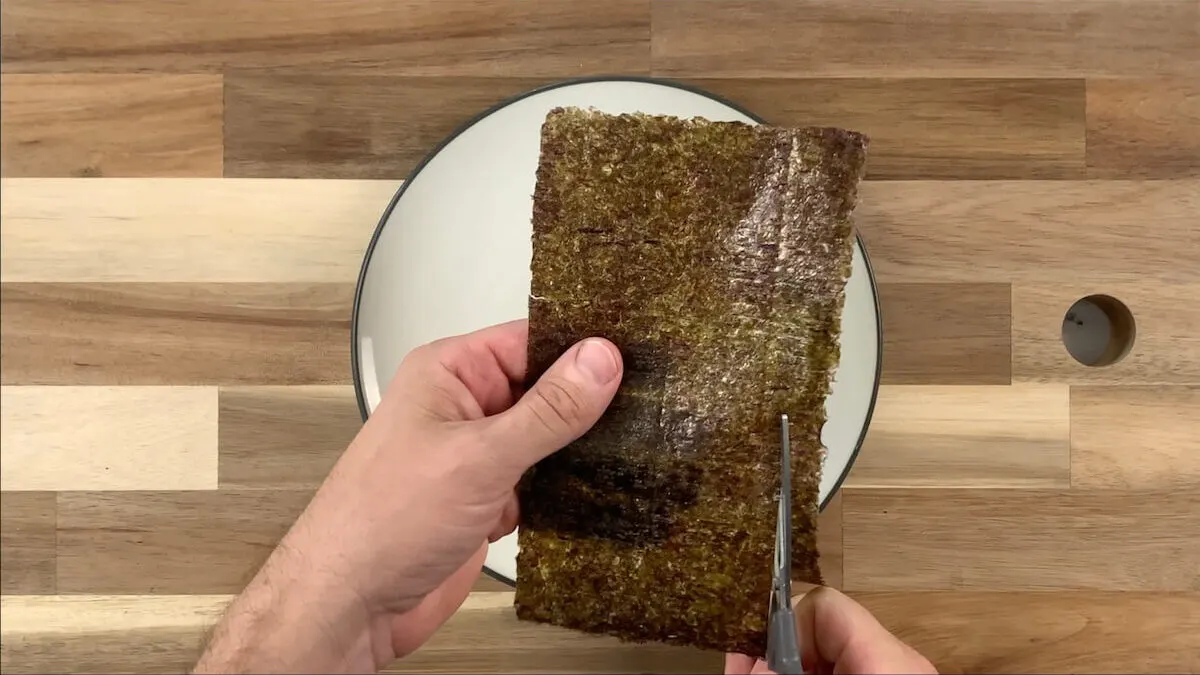
2. Mix a splash of rice vinegar into a bowl of water and wet hands. This helps prevent rice from sticking to your hands. After wetting your hands, use your first two fingers to form a small ball of sushi rice into the shape of a cylinder. The exact size depends on the size of your tamagoyaki slices.
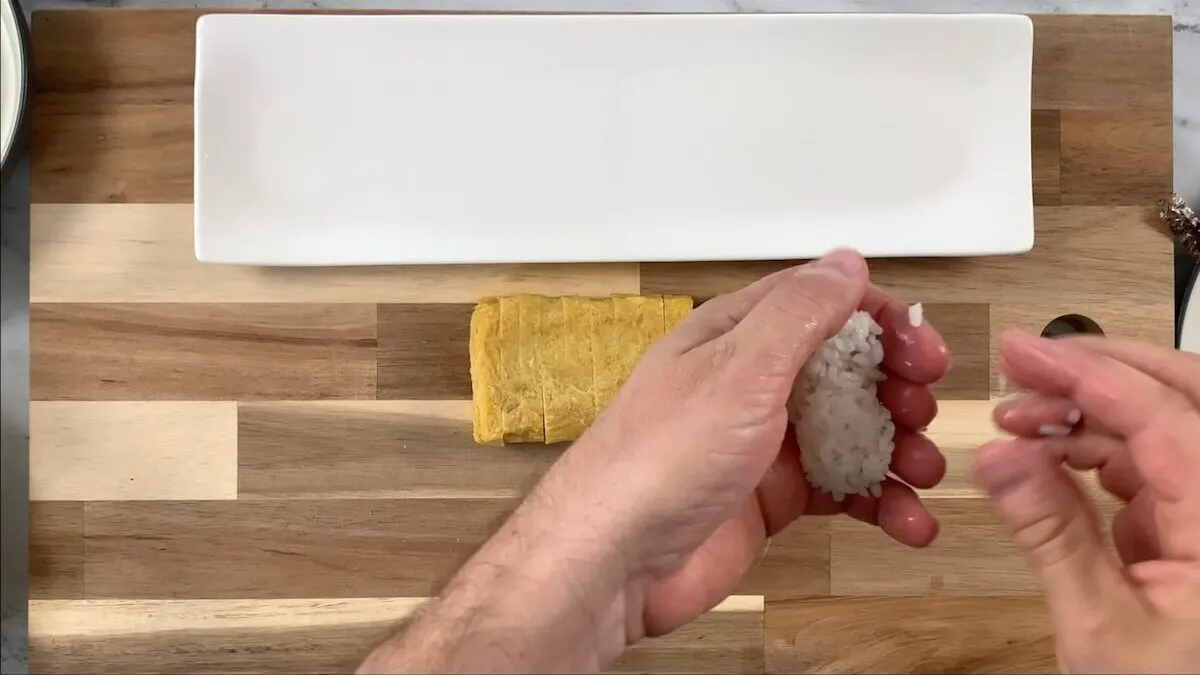
3. Drape tamagoyaki slice over the sushi rice ball.
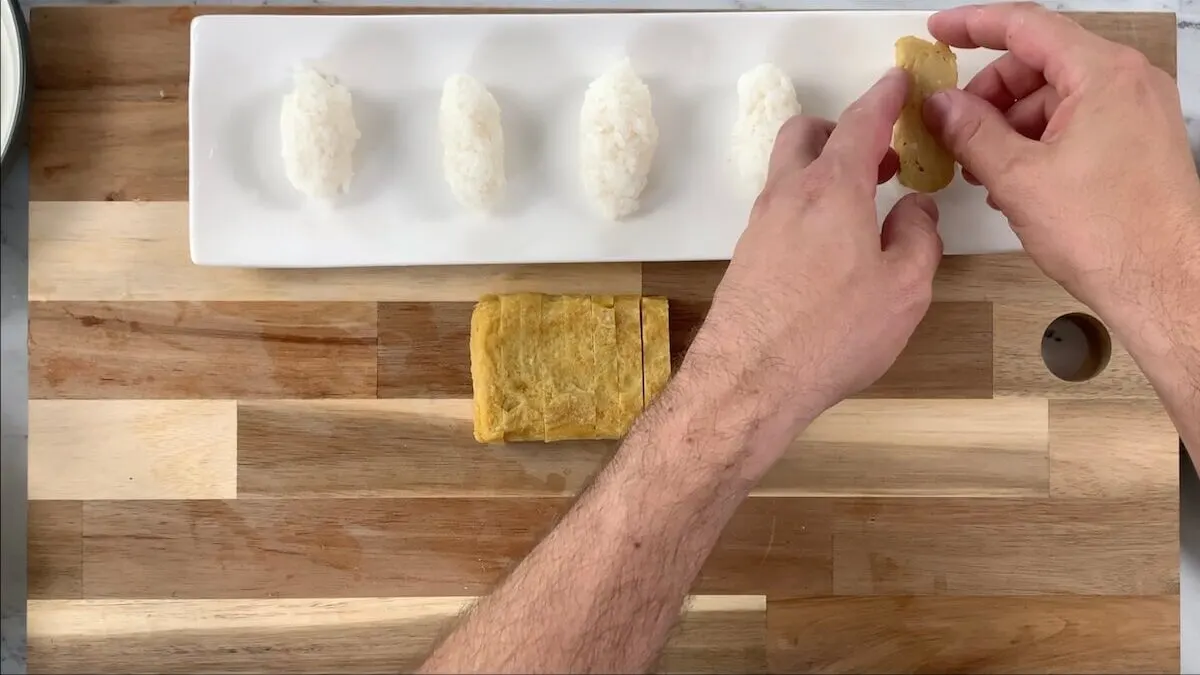
4. Wrap the nori strip around the tamagoyaki slice and rice ball to hold in place. I would wet one end of the nori strip to help it stick.
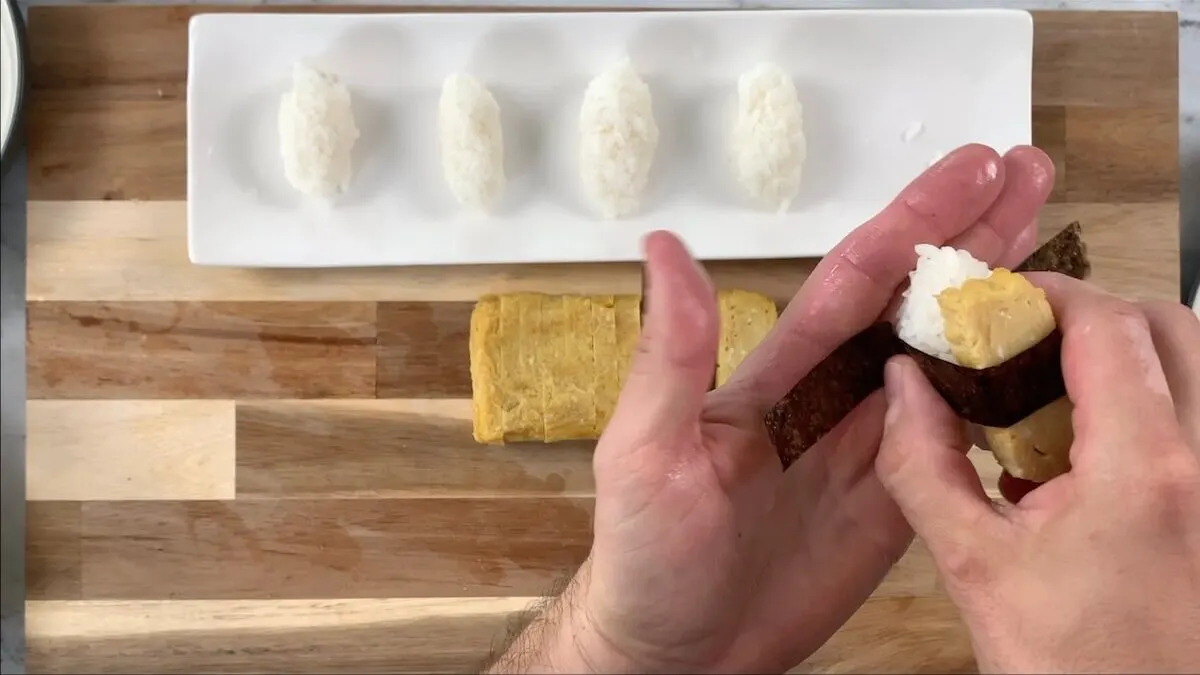
5. Serve with soy sauce, wasabi, and pickled ginger!
Tamago Sushi Recipe
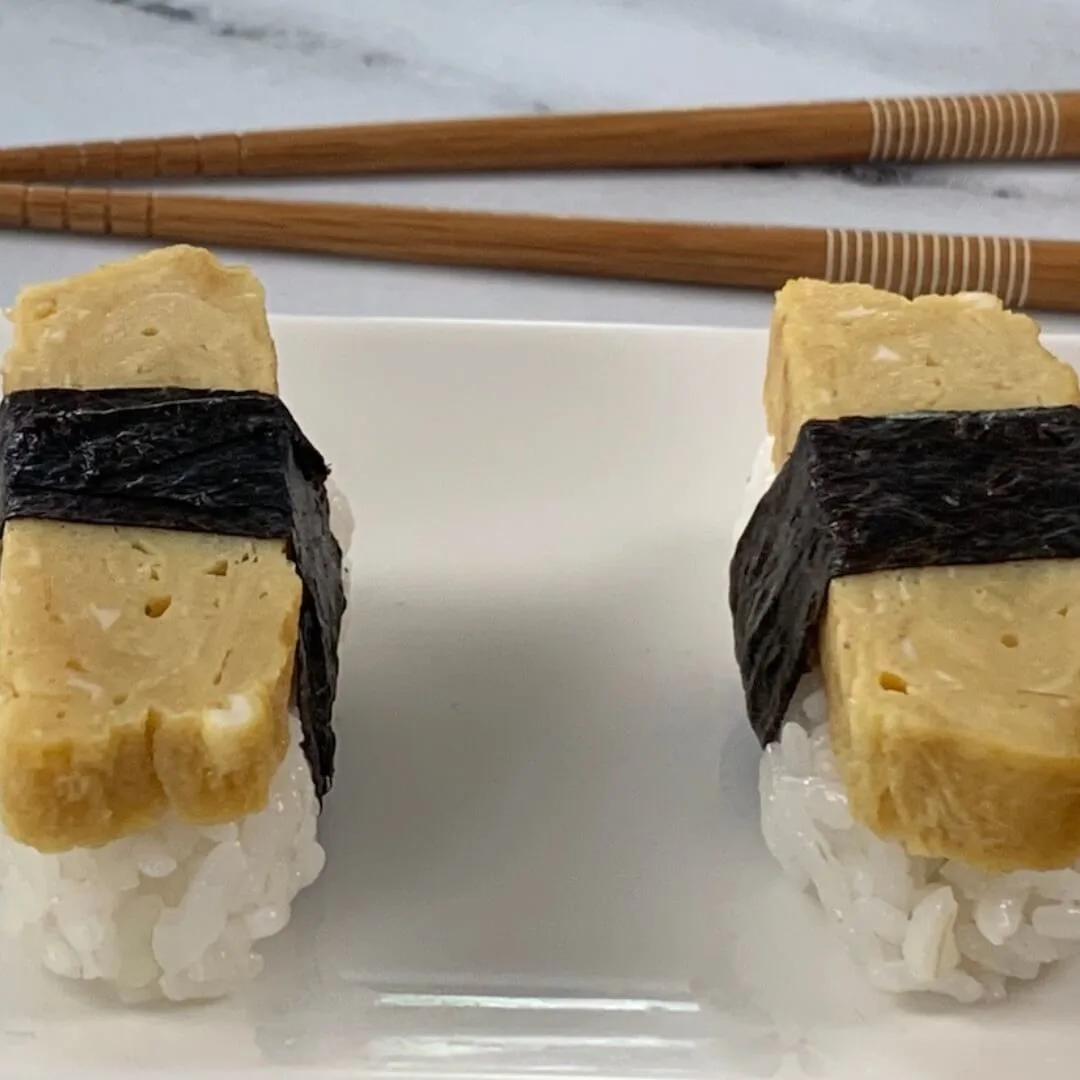
Tamago Sushi Recipe
Equipment
- 1 Pot for cooking sushi rice
- 1 Sharp knife and cutting board
- 1 Tamagoyaki Pan (Can be replaced with a small round non-stick pan)
- 1 Mixing bowl
Ingredients
- 2/3 Cup Sushi Rice dried, will cook to 2 cups
- 2 Tbps. Sushi Vinegar
- 2 Nori Sheets Cut into strips
- 3 Eggs
- 1 Tbsp. Mirin
- 1 tsp. Dashi Powder
- 1 tsp. Sugar
- 1 tsp. Soy Sauce
- Canola Oil
Instructions
Cook Sushi Rice
- Rinse 2/3 cup of sushi rice by placing it in a colander and running water through it until the water is clear.
- After the rice is rinsed, add it to a sauce pan with 1 cup of water (I would check the instructions on the sushi rice package to see exactly how much water to add as it can vary depending on the brand).
- Bring the water to a boil and then reduce the heat to low. Cover and let the rice simmer for 20 to 30 minutes, or until the water is absorbed and the rice is soft.
- Remove the rice and place into a bowl or dish and let cool. I would line the dish with parchment paper prior to adding the rice to avoid sticking.
- Mix two tablespoons of sushi vinegar into your rice. Stir until it has absorbed into the rice. Once cooled and fully absorbed, your rice is ready to roll!
Prepare the Tamagoyaki
- Add the eggs, mirin, soy sauce, sugar, and dashi powder to a mixing bowl and beat with a whisk until everything is thoroughly mixed. I like using dashi powder in this mixture because it provides a strong concentration of dashi flavor to the omelette. However, you can substitute with two tablespoons of dashi if you would like a more subtle dashi flavor in your tamagoyaki.
- Heat a tamagoyaki pan or skillet on medium heat until hot.
- Spread a thicker layer of oil on the bottom of the pan. I soak a folded paper towel in canola oil and use that to spread oil across the bottom and sides of the pan with tongs or chopsticks.
- Pour approximately 1/4 of the egg mixture into the bottom of the pan. Tilt the pan to make sure it's evenly spread across the bottom of the pan.
- Once the egg starts cooking (around 30 seconds depending on how hot the pan is), use a spatula or chopsticks to fold the egg mixture on top of itself towards one side of the pan. At this stage, the omelette doesn’t need to look perfect. It will look better with each layer. Tip: Check out the video for this recipe to see a demonstration of this process.
- Add another 1/4 of the mixture to the bottom of the pan. Gently lift the mixture that has already been folded and tilt the pan assuring the mixture is spread evenly across the bottom of the pan (including under the mixture that has already been folded).
- Once the second layer of egg starts cooking, use a spatula or chopsticks to fold the egg mixture on top of itself and the already cooked layer of folded egg. I like to use a spatula to form the egg into a rectangle shape as you fold each layer.
- Repeat the process two more times until all the egg mixture has been used. You may need to add more oil to the pan between layers if you find that your eggs are sticking.
- After the final layer, use a spatula to shape the tamagoyaki into a rectangle shape.
- Once cooked, slice into 12 evenly sized slices.
Assemble the Tamago Sushi
- Cut the nori sheets into strips about one half an inch wide.
- Mix a splash of rice vinegar into a bowl of water and wet hands. This helps prevent rice from sticking to your hands. After wetting your hands, use your first two fingers to form a small ball of sushi rice into the shape of a cylinder. The exact size depends on the size of your tamagoyaki slices.
- Drape tamagoyaki slice over the sushi rice ball.
- Wrap the nori strip around the tamagoyaki slice and rice ball to hold in place. I would wet one end of the nori strip to help it to stick.
- Serve with soy sauce, wasabi, and pickled ginger!
Video
Nutrition
Frequently Asked Questions
Is tamago sushi healthy?
Yes, the primary protein in tamago sushi is egg, which is very healthy. Egg is high in protein and contains many essential vitamins.
Is tamago sushi popular in Japan?
Yes, tamago sushi is popular throughout Japan. It’s commonly enjoyed among people of all ages.
Final Thoughts on Tamago Sushi
A healthy dish that even your kids will enjoy, tamago sushi is a healthy meal you can enjoy with your whole family. I hope you enjoy this sushi as much as my family does. Happy cooking!
For more fun recipes, check out the below articles:
Unagi Don (Eel Rice Bowl) Recipe
Also, subscribe to our YouTube Channel for some great videos!
